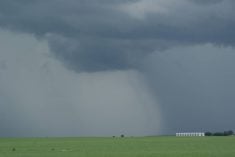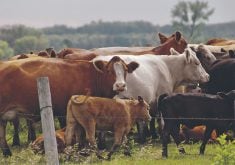Remembering the war
We remember very little of our preschool years, unless the memory is strong. Such was the case for me of the Second World War.
Mom and Dad, day after day, anxiously listened to news about the war from a small radio that sat on a ledge between the kitchen and the living room. As a small child in the background I sensed their fear and concern and remember feeling scared and sick to my stomach at times.
Grade 10 students in an English class at the Elrose Composite High School wrote one-sentence responses to various words.
Read Also

Farmer ownership cannot be seen as a guarantee for success
It’s a powerful movement when people band together to form co-ops and credit unions, but member ownership is no guarantee of success.
The following choral speech reading, “In Our Own Words” will be recited at the Remembrance Day service in their school on Nov. 8.
In Our Own Words
War :
The first thing I think of is soldiers leaving home.
Whole families are
involved; everyone is hurt.
Naive young men head off in uniform to an unknown fate.
Bombs, guns. People die for what they believe.
Involvement in war is sometimes necessary for
freedom, for true peace.
Remembrance:
Remember the memories that many wish they could forget.
Take some time to think about all those who fought to make our lives better.
Remember those who fought for us and died for us.
Remember the damage done to towns, cities, countries.
Remember – so people are aware of the devastation and destruction of war.
Remember the soldiers who fought against oppression.
Most people only stop to remember on Nov. 11, some don’t stop to remember at all.
If we forget what war is, another world war could happen. Life as we know it could be over.
Pay tribute to the sacrifices made for you.
Wear a poppy in honor of those sacrifices.
Peace:
The dove of peace flies
over us.
Freedom:
Be proud! Not all people have it.
If everyone tried to
co-operate, there could be no more war.
After a war, no one wants to go to war again.
We often take both freedom and peace for granted
because it is the only way of life we have ever known.
Canada:
So much was sacrificed to keep her – us – safe.
So much we take for
granted.
Now, Canadians try to help other countries to have peace.
The Canadian flag flies proudly above us.
Remember how blessed we are.
Sponge and leftover Christmas cake
Dear TEAM: I’m looking for two recipes from the 1930s and 1940s. The first involved leftover Christmas cake, custard and toasted bread crumbs. I had forgotten all about this dessert until I heard a clip of Kate Aikens on CBC radio talking about how to use dried fruit cake.
The second recipe I wish I had from the depression era was a steamed sponge pudding that used Rogers Golden Syrup. I remember it was brown on the outside and golden throughout and very like a coarse textured cake. It was eaten warm with milk or syrup dripped over it. It had no fruit or nuts. I do remember the batter being poured into a pudding bowl or basin, parchment paper tied over it and then steamed in a large kettle for what seemed like hours to a hungry little kid. It may have been a Canadian depression recipe or one brought over from Scotland. Of course, like many childhood memories, these recipes might not have been as nice as they seem in hindsight. It was comfort food in hard times. – R.B.C., Saskatoon, Sask.
Dear R.B.C.: The cook likely brought the recipes from Scotland. My Scottish friend Norma says sponge puddings were often served in her home in Scotland. She also remembers having leftover Christmas cake for dessert, served with a custard pudding poured over the heated cake. She doesn’t remember the bread crumbs but they certainly could be added.
I wasn’t able to find a written recipe for the Christmas cake pudding. No doubt the frugal cooks made up these puddings with whatever was at hand.
Hopefully, the following sponge pudding recipe is like the one you remember.
Syrup sponge pudding
2 cups flour 500 mL
1Ú2 cup suet, 125 mL
butter or margarine
1Ú4 cup sugar 50 mL
1 teaspoon ginger 5 mL
1Ú2 teaspoon baking 2 mL
soda
3Ú4 cup milk 175 mL
3Ú4 cup golden 175 mL
syrup
1 egg 1
Mix all well together. Put into greased basin and cover with greased paper. Steam for 21Ú2 hours.
Hints: Steamed puddings should be kept boiling sharply or they become heavy. Fill pot with water to 3Ú4 up the pudding basin and add water as necessary. A plate can be put on the bottom of the pot and the pudding basin set on it. Extra heated syrup can be poured over the sponge before serving.
Source: S.W.R.I. Jubilee Cookery Book, 1971, eighth edition. Published by the Scottish Women’s Rural Institutes, 42 Heriot St., Edinburgh, Scotland EH3 6EU.
Folic acid
Coast to Coast, a cookbook containing recipes rich in folic acid, has recently been published as a fundraiser by the Spina Bifida Association of Canada.
Research has shown that if women of childbearing age consume a folate-rich diet they will reduce the chances of giving birth to a child with neural tube defects. Many recipes in the cookbook are rich in folic acid, with the folic acid content per serving for these recipes given.
Since 1993, Health Canada has recommended women planning a pregnancy choose foods high in folic acid. The Canadian recommended intake for a woman is 180 micrograms (0.18 milligrams) daily but those planning pregnancies should more than double that to 400 micrograms (0.4mg) per day. This ensures stores of folic acid in the body are sufficient at the time of conception and during early fetal development.
Folic acid, a member of the vitamin B family, is important in cell growth, which is highest during pregnancy. Pulses, especially lentils, as well as chick peas, beans and peas are excellent sources of folic acid as are green leafy vegetables such as spinach, asparagus, brussels sprouts and broccoli.
Copies may be obtained from: Spina Bifida Association of Canada, 220 – 388 Donald St., Winnipeg, Man., R3B 2J4, 1-800-565-9488 for $10 (includes GST and postage).














